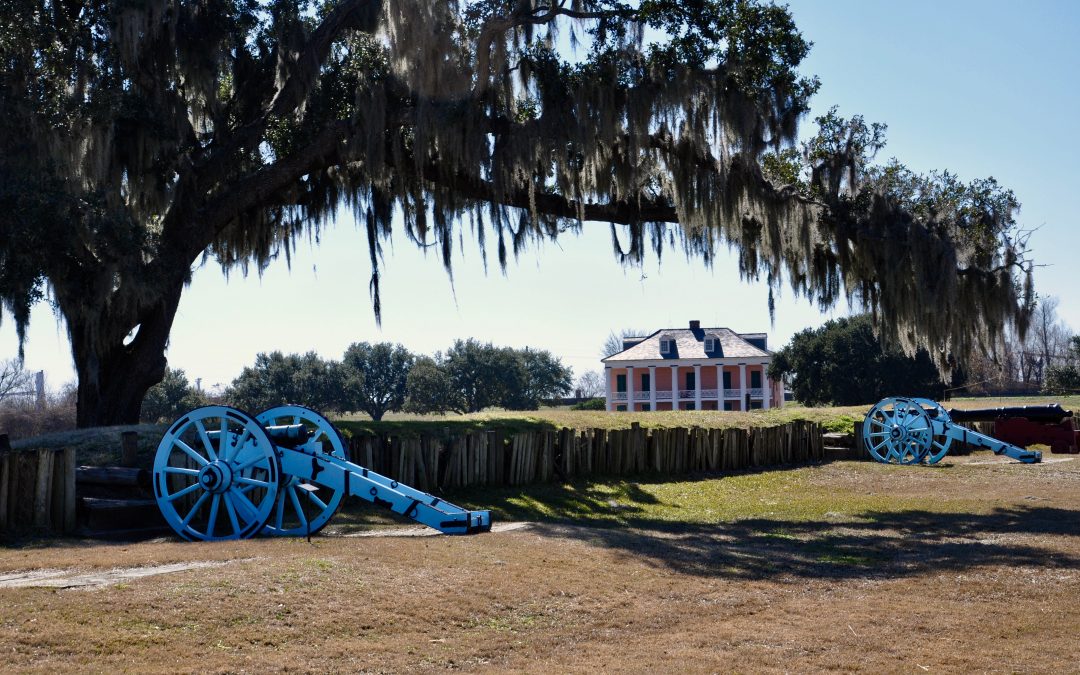
by admin | Mar 29, 2011 | Greater New Orleans, Most popular
Lured into St. Bernard Parish by a festival, we ended up staying late into the evening to see plantations, a battlefield and chickens. That’s right, chickens kept us out way past nap time. But I digress. It all started when I saw the newspaper article about the Los Islenos Festival. Having skipped it the last two years, I was determined to go. So we called a friend who lived in “The Parish,” as St. Bernardians call their beloved home, and made plans to meet up with her there.
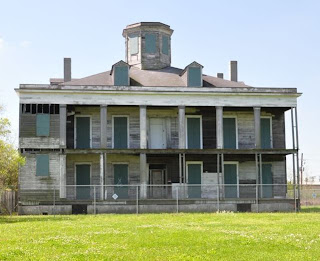 |
| LeBeau Plantation |
Driving along the back end of the French Quarter, past Bywater and the Lower Ninth Ward, we had a short pit stop to see two plantations that, although within walking distance of each other, are as different as night and day. LeBeau Plantation’s boarded up remains stand eerily proud behind a deep, grass field and a chain link fence. The new roof is in curious contrast to the gaping holes in the wall, but the home lends itself to being photographed. Meanwhile, on the property of the Domino Sugar Plant, the stately Cavaroc mansion appears well-loved in its pristine state. A word to the wise, though, snapping a picture of this beauty will earn you the disdain of the Domino Sugar guards, who descended upon our car, scrawling down our name and license plate number like we were suspected terrorists.
 |
| Chalmette Battlefield |
Fleeing the scene of the crime, we continued on to Chalmette Battlefield, which marks the site of the Battle of New Orleans where General Andrew Jackson and his ragtag group of American troops held off the British attack during the final struggle of the War of 1812. Beginning in the newly built visitor’s center, we pressed the button to start the video while I mentally calculated how long I had before having to take off in a chase after Charles. Amazingly, the moving lights of an accompanying diorama kept his attention, and for the first time in years, we were able to see an entire movie. In the end, I broke his attention and dragged him away to look at a large drum so he didn’t see the final results of the war graphically displayed across the screen.
Back outside, he proudly waved his miniature American flag while we led him toward the oddly small Beauregard Plantation, built on the property in 1840. After posing for family pictures in front of our pretend home, we explored the empty rooms inside. The temperature dropped remarkably when we stepped onto the marble floors and felt the cool breeze blowing across the open, facing doors in every room. August lazily watched Charles racing through the house, while I stopped the toddler in his tracks by pointing out a “secret” door to the attic. Little did I know that the door would become the primary topic of discussion for the rest of the day, leading to elaborate stories about a six-armed green monster locked away by the superhero Batman.
The plantation sits on the edge of the Mississippi River levee, and after a quick climb up the steps, we were delighted to catch a glimpse of the Creole Queen paddlewheeler floating by. Another top attraction at the site is the multitudes of crawfish chimneys lining the path to the cannons. Charles was fascinated with peering inside, desperately trying to see the crawfish at the bottom.
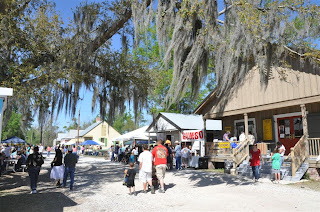 |
| Los Islenos Festival |
Now starving, we made a beeline down the San Bernardo Scenic Byway, passing under an avenue of live oak trees flanking the roadway, to the food booths at the Los Islenos Festival. Advertised as “A celebration of Louisiana’s Spanish Heritage,” the festival paid tribute to the Canary Islanders who settled in the region in the 1700s. Along with Spanish food, music and dancing, we found local craft booths and spacewalks scattered throughout the Los Islenos Historic Village. After refueling on paella and sangria, we explored the museum-quality homes and their endless contribution of “secret doors.”
We enjoyed a few moments of rest while listening to the large group of Spanish singers on stage before packing everyone up and heading home. One last detour was meant to be a quick in and out picture of the Sebastopol Plantation. Being a private residence, we were surprised to see a sign advertising free tours from noon to 4 p.m. Not only is it a rare event to stumble upon free entrance into a plantation, it is even more amazing that at 4:30 p.m., the owner and curator, Alberta Lewis, saw us stop our car and came to offer us a tour past closing time.
 |
| Sebastopol Plantation |
Charles, August and I made it almost through the history of the first room before having to go outside and spare the house from damage. While Paul was given a guided presentation of the 180-year-old house, the kids and I met a friend of the owner who engaged Charles in picking up pecans across the expansive yard. He then led us to the chicken coop, where roosters, chickens and two peacocks strutted all around our feet. We left carrying a basket of pecans, half a carton of fresh eggs and a lasting memory of the generosity of two St. Bernardians (one of whom also happened to be the talented artist behind Haydel’s king cake dolls).
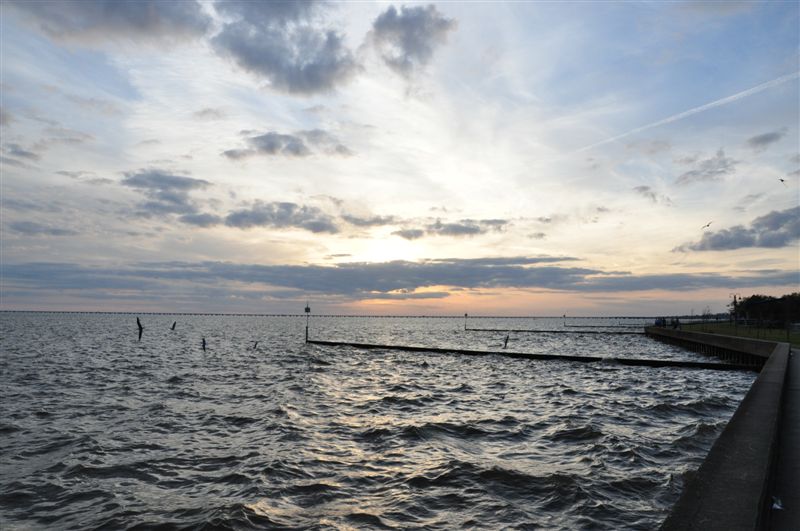
by admin | Mar 14, 2011 | Greater New Orleans
Every Monday morning, thousands of people wake up at the crack of dawn to leave their homes and drive across the longest bridge in the world to their jobs in the city. A lover of sleep and a hater of traffic, I’ve always wondered what could possess someone to willingly choose that daily commute across Lake Pontchartrain. But as one coworker described it, there’s a certain point on the drive home when the New Orleans’ skyline fades away and so does all the stress that comes with it. St. Tammany Parish, also known as the Northshore, is home to quaint towns that pride themselves on not being a suburb of New Orleans. This weekend, we decided to see what it is about the Northshore that lures people across that 24-mile-long Causeway Bridge.
Getting a late start, we were already hungry for lunch before we reached the Interstate. So we rerouted our original plans, bypassing Mandeville and Covington and heading straight for Abita Springs and the Abita Brew Pub. Once the home to the actual brewery, now the restaurant serves up oversized portions of salads, hamburgers and other entrees along with a wide selection of Abita beer. Eating establishments are always touchy with two small kids, but the free crayons and coloring sheet went a long way toward keeping Charles in check until his shrimp and french fries arrived. Of course, he scarfed them down in 2.4 seconds and then bolted out of his chair in search of mischief. Luckily, I have learned to eat equally fast and was able to guide him out the door while my husband, Paul, paid.
 |
| Indian princess kneeling over the spring |
Abita Springs is tiny as far as towns go. It’s one of those places where if you blink while driving too fast, you’ll miss the downtown. You’ll be sorry if you do, though. Walking out the front door of the Brew Pub, we found ourselves standing on the Tammany Trace, a railroad track turned into a bike/jog/horseback ride path that runs across St. Tammany Parish. The Trace plunges you deep into nature and then opens up at each town or city it passes. Dodging the bicyclists, we crossed the trail and headed toward the large gazebo built in 1884 for the New Orleans World’s Fair. It was reconstructed over — what else — but the famous spring that once lured tourists with its clean waters. Today, a statue of an Indian princess kneels over the bubbling water.
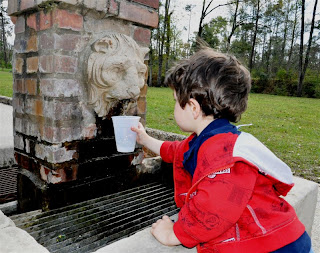 |
| Lion’s Head fountain pouring spring water |
As we walked toward the town museum, Charles spotted a man carrying an instrument and ran off to investigate. Within minutes, several more musicians arrived and started up their weekly concert. We admired the music until the museum guide revealed to Charles the secret for starting up the water park and then gave him a cup to collect water from the lion’s head fountain. He was so fascinated by drinking the water pouring out of the lion’s mouth that he never even noticed the playground looming large behind us.
Anxious to continue our journey, Paul steered us toward the car and the Nature Conservancy’s Abita Creek Flatwoods Preserve where a boardwalk runs through a long-leaf pine savanna and swamp. Unfortunately, the carnivorous yellow pitcher plants were not in season, but it was still a pleasant walk on a perfect, 70-degree day.
Back on the road, we headed south on 59 and stopped off at Tammany Trace Headquarters and the Kids Konnection playground. While I fed August his unappetizing jar of turkey and vegetable dinner, Paul and Charles went off to play in the sand pit. At the visitor center half a mile down the road, we picked up glossy brochures highlighting all the places we missed before continuing on to scenic Mandeville. A drive along the shores of Lake Pontchartrain tempted us to stop the car and take a stroll. Behind us, couples enjoyed romantic dinners in restaurants overlooking the sun setting on the massive lake.
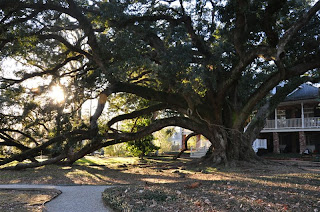 |
| Seven Sisters live oak tree |
There was only time for one last stop before making our way back across the bridge, and Paul led us deep into a neighborhood to find the Seven Sisters, the oldest live oak tree in Louisiana. He couldn’t hide his enthusiasm at finding the gem and had to sneak up the driveway of the private property to take this picture.
While the kids were lulled to sleep by the monotonous bumps of the bridge, I pulled out the brochures and made a quick wish list for the future. We had only touched the stem of St. Tammany Parish and had much to go back and see. So what’s on the list for next time? Well, for starters, there’s Fountainebleau State Park, Camp Salmen, the Global Wildlife Center, Saint Joseph Abbey, and on and on and on…

by admin | Mar 8, 2011 | Greater New Orleans
There are some things in life that children have to learn at an early age. Take football, for example. I’m determined to have my toddler, Charles, recite the LSU Fight Song before he can fully sing the alphabet. Likewise, you are never too young to learn to appreciate Mardi Gras. There is one more day left in this year’s Mardi Gras season, and August has already been to 14 parades. That’s pretty hard core for a 7-month-old.
Now there are always days, like Saturday, when you wonder if it’s worth it. We were watching Iris on Napoleon when the first drops of rain warned us it was time to leave. With no umbrella and having walked more than a mile to the parade, we didn’t have time to make it back to the house. So we holed up in a nearby coffee shop, where we sat for nearly two hours while watching a river flow down what used to be Dryades Street. Mind you, this was two hours trapped in one small room with two small children and a stroller overflowing with beads, toys and stuffed animals. All I can say is we all went to bed early that night, some of us by choice and others by force. But then the next morning, you wake up refreshed and set off again to enjoy the last few days before Lent.
 |
| Charles with his “trombone.” |
I’ve learned that age plays a large part in enjoyment level. The super krewes of Bacchus, Endymion and Orpheus, with their celebrity riders and elaborate floats, draw the huge crowds. At one time, my husband and I were annual regulars at these three parades. Then, enter two small children. Priorities change and so do our parade plans.
Take Charles, for starters. Three weeks shy of turning three, his latest obsession (along with Batman and Spiderman) is trombones. Sure, the throws are nice, and a nervous breakdown is almost always in the forecast when he doesn’t catch a football, but mostly he’s there to get up close and personal with the bands. He wants to be on the front row and have plenty of room to dance and march at his leisure, which equals no love affair with large crowds.
 |
| August enjoying a parade. |
Now, August, on the other hand, wants nothing to do with loud noises. You can imagine our dilemma with that one. After the first parade, though, I discovered that all he really wants is to be held close — cocoon-like — so he can drift off to sleep. With this revelation, I packed him tightly into his Moby Wrap, and for the next 13 parades, he had the best sleep in ages.
Armed with our new knowledge and lots of trials and errors, we finally developed some pretty sound advice for other families venturing out into carnival: 1) Start at the beginning of the route. If a parade begins on Magazine and Jefferson at 5 p.m., don’t try and catch it on Napoleon or St. Charles — and certainly not on Canal. Go to Magazine. On any given day, the crowds range from light to manageable, and you rarely have to fight a ladder for a good viewing spot. 2) Bring lots of snacks and drinks. You might think you’ll only be there an hour, but the reality is going to be much longer. 3) If you can, walk from your house. In the long run, it’ll be quicker and easier. If you must drive, go late and check out the close spots first before parking a mile away. We’ve been lucky on several occasions, garnering a choice spot just a block from the route minutes before the parade started. 4) Be mentally prepared to leave when necessary. While Mardi Gras is all about having fun, it often also means no naps, long hours of over-stimulation, countless sugar highs from all that king cake and daily meltdowns over a lost blinking dragon or broken sword. 5) And, lastly, bring an umbrella. You never know when you’re going to need it.












